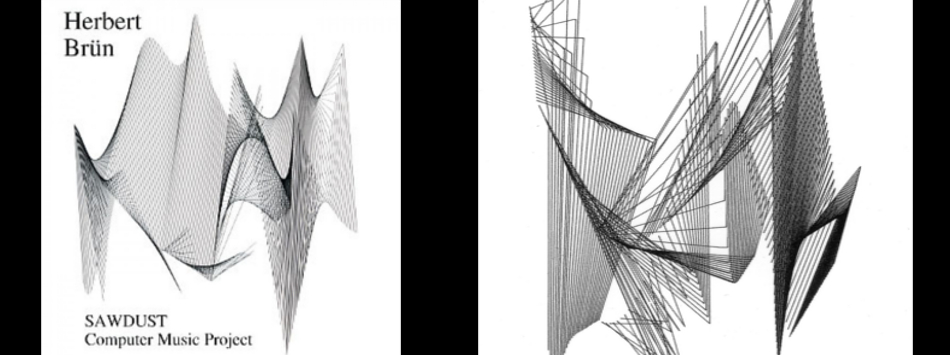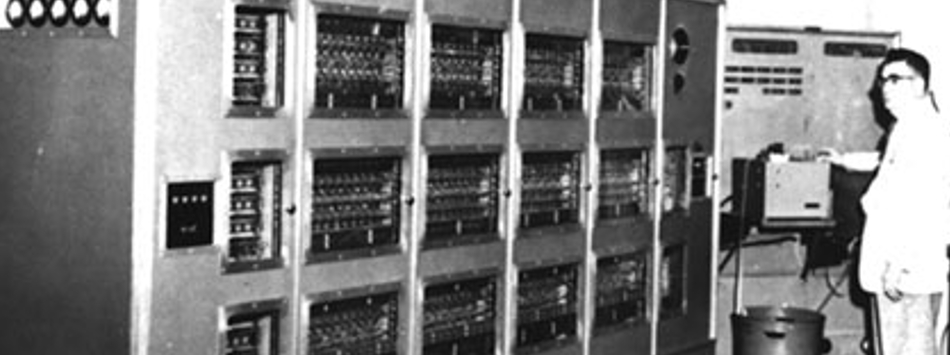James W. Beauchamp Computer Music Project
History
.
1984 - Computer Music Project is established with the help of a $9,000 National Endowment for the Arts Grant for New Music Centers, a $14,000 UIUC Campus Research Board Grant both submitted by James Beauchamp, Herbert Brun, John Melby and Sever Tipei (PI), and a $5000 School of Music contribution. The grants were used to purchase a Logical Micro Computer (LMC), a single-user microcomputer, a Selanar terminal, an 85MB Hard Disk, a Siemens inkjet printer and cables. Dean McKenzie names James Beauchamp Director of The Computer Music Project, "a facility for composition requiring computer resources as well as for related research." Herbert Brun, Sal Martirano, John Melby, Sever Tipei and Scott Wyatt are asked to serve as a policy committee.
1984/85 - More Research Board grants are obtained for the purchase of additional equipment.
1985 - Computer-based Education Research (CERL) group on campus builds an analog/digital/analog system to be attached to CMP's LMC computer "capable of sustaining a 50 KHz sampling rate."
1985/86 - SCSS (Sound Conversion/Storage System) is created by Kurt Joseph Hebel as a project for Music 320, "Topics in Computer Music." It had its own processor and 200MB of storage for samples and stereo 16-bit A/D and D/A conversion. Music 4C (M4C), a translation in the C language of Hubert Howe's 4BF FORTRAN program, is also developed in the same course by Scott Aurenz. Sever Tipei's MP1, a program for computer-assisted composition becomes part of the CMP software.
1986 - First compositions produced in CMP by Monroe Golden and Kwok-Ping (John) Chen using M4C. Development of an Apple Macintosh System (Mac a Plus) as a Music Workstation, the first one in the School of Music. Software developed in CMP by faculty and students starts running on NCSA's CRAY X-MP, and later on CRAY Y-MP, supercomputers. James Beauchamp and Rob Maher collaborate on the public domain acoustical analysis/synthesis package, SNDAN, used in the US and abroad. Diane Cook starts working on Orpheus, a music printing program.
November 1986 - an Excellence in Computer-Aided Education and Learning (EXCEL) grant from the IBM Corporation of $86,000 and $6,300 Campus Support are used to acquired two IBM RT Model 125 (risk technology) computers as well as monitors and printers, connected to SCSS.
1987 - The Research Board grants James Beauchamp, John Melby, Sever Tipei and their students access to the CYBER computer (36,000 SU's). Two IBM AT computer are acquired, one to be used for musical acoustics demonstrations created by Rob Maher.
August 1987 - The International Computer Music Conference with 350 participants and a Computer Music Workshop are organized by James Beauchamp and Sever Tipei. Keynote speakers are Iannis Xenakis and Max Mathews; IBM, AT&T and YAMAHA are among the sponsors of the conference. This is the second time ICMC was held at the University of Illinois - the first time, the conference, organized by James Beauchamp, Herbert Brun and John Melby, took place in November 1975 under the name Second Music Computation Conference.
1988 - David Kelley creates GrafPro, an interface between MP1 and Leland Smith's Score program.
1989 - Release of the CENTAUR CD, Experimental Music Studios and Computer Music Project at University of Illinois at Urbana-Champaign, volume 3 in the CDCM Computer Music Series, with works by Herbert Brun, Salvatore Martirano, John Melby, Carla Scaletti, Sever Tipei, and Scott A. Wyatt. Sever Tipei introduces the term "manifold composition" in a paper Manifold Compositions - a (Super)computer-assisted Composition Experiment in Progress presented at the ICMC in Columbus Ohio.
1990 - CMP is connected to the internet and a NeXT computer, obtained by James Beauchamp, is added to the lab. It is followed next year by a second NeXT workstation. Sever Tipei, Robin Bargar, Ben Cox and David Kelley present a paper, Computer Music Courses Using Supercomputers, at the ICMC in Glasgow.
1991 - Christopher Kriese implements a Digital Instrument for Additive Sound Synthesis (DIASS), a M4C instrument; it will run on CMP computers as well as on NCSA's CRAY and, later, at Argonne National Laboratory. Aga Matter, for piano and tape, by Sever Tipei and Christopher Kriese, is the first composition produced with DIASS - it will be performed in the US, South Korea, and Romania.
1993 - A $26,000 IBM grant, SUR (Shared University Resources), enabled the purchase of an IBM RS-6000 computer for research in digital sound synthesis and automatic printing of music. A collaboration focused on sonification of complex scientific data, digital sound synthesis, sound visualization, and computer-assisted composition is established between CMP and Argonne National Laboratory - it will last until 2003. Dr. Hans G. Kaper, Senior Mathematician at ANL is eventually appointed Adjunct Professor in the School of Music.
1993/1997 - James Beauchamp and Sever Tipei co-direct the Computer Music Project. New furniture, carpets and sound treatment are installed. CMP becomes part of the Experimental Music Studios (EMS).
1993/2003 - Sever Tipei and students in the course Music 320, Advanced Computer Music, develop software for sound synthesis (M4C_ANL), composition (MANIFOLD), and sound visualization (M4CAVE), running on the Argonne National Laboratory IBM Scalable powerParallel (SP) computer and on the CAVE virtual environments both at NCSA and ANL.
1995 - CMP 10 Year Anniversary concert takes place.
1995/1998 - CMP/ANL software for sonification, sound visualization, and sound synthesis is demonstrated at SuperComputing - SC (International Conferences for High Performance Computing, Networking, Storage, and Analysis) held in San Diego, Pittsburgh, San Jose, and Orlando.
1996 - Six NeXT computers were donated by the Argonne National Laboratory. Hans G. Kaper, David Ralley, Sever Tipei and, later, Jesse Guessford start working on a software implementation of Perceived Equal Loudness of Complex Tones, a unique feature not available on other synthesis engines.
March 1997 - A SGI O2 computer and software is added to CMP; a second SGI O2 will soon follow. Sever Tipei becomes Manager of CMP, with Scott Wyatt Director of EMS.
1998 - Over 150 variants of A.N.L.-folds, a manifold composition, are produced on the IBM Scalable powerParallel (SP) with DIASSM4C at Argonne National Laboratory, and are performed in US, Australia, Berlin, Madrid, and Romania.
December 1999 - The first Intel (Penguin) Linux computers arrive. CMP will gradually switch to Dell Linux computers purchased with funds provided by the School of Music and the College of Fine and Applied Arts Tuition Differential Funds.
2000 - Hans G. Kaper, Sever Tipei and Jeff Wright introduce DISCO (Digital Instrument for Sonification and Composition) at the ICMC 2000 in Berlin. It is written in C++ with a Python interface.
2002 - Braden Kowitz designs Moss, which will later become LASS (Library for Additive Sound Synthesis), in C++, no longer a MUSIC N program; it is developed as part of the course Advanced Computer Music.
2003/2005 - Students enrolled in the course Advanced Computer Music re-write the Composition Module (CMOD) designed by Sever Tipei and enhance LASS, creating a DISSCO (Digital Instrument for Sound Synthesis and Composition) open source software, available from SourceForge.
2008/2009 - Sever Tipei is appointed NCSA/University of Illinois Faculty Fellow. Ryan Cavis streamlines DISSCO and, in collaboration with NCSA's Volodymyr Kindratenko, develops SoundMaker: a Web-based Teaching Tool for Sound Design, which is presented at ICMC 2009 in Montreal.
2010/2011 - Andrew Burnson and Ming-ching Chiu add new features to DISSCO.
2011 - Mert Bay implements BiQuadratic filters in DISSCO.
2012 - Ming-ching Chiu writes LASSIE, a Graphic User Interface to DISSCO, enabling an easier and more accurate access to the software.
2012-2014 - James Beauchamp gives Agora classes in CMP for the Uni High (University High School) students.
2013 - DISSCO-2.0 is released.
2014 - CMP 30 Year Anniversary Concerts I and II take place.
2015 - Zhaoyu Zhang's DISSCO composition Power of the Script for trombone and electronics is premiered by Xianzhe Li at the WOCMAT (Workshop On Computer Music and Audio Technology) Conference, National Chiao Tung University, Taipei, Taiwan.
2016 - Sever Tipei's DISSCO composition Big Gizmo is presented at Diffrazioni Multimedia Festival in Florence, Italy. Tipei becomes a NCSA Faculty Affiliate. As a mentor in the NCSA SPIN (Students Pushing Innovation) program Tipei preents a paper and a poster in Florence, Italy and Istanbul, Turkey co-authored with SPIN students Rishabh Rajagopalan, Xuqing Sun and Shenyi Wang. The concept of Evolving Entity is presented at conferences in Hamburg, Germany and Utrecht, Netherlands.
2017 - M.O. Abbott's DISSCO composition "I Said Top-Top" is presented at ICMC 2017, Shanghai Conservatory of Music, Shanghai, China. A collaboration with the San Diegeo Supercomputing Center begins, part of the XSEDE (Extreme Science and Engineering Discovery Environment) program funded by the National Science Foundation; a parallel version of DISSCO is created.
2018 - A 16-channel version of M.O. Abbott's DISSCO composition "I Said Top-Top" is presented at the National Student Electronic Music Event (NSEME), University of North Texas, Denton, TX, and a 9-channel version is presented at the Noisefloor Festival, Staffordshire University, Stoke-on-Trent, UK. Sever Tipei's DISSCO composition Big Gizmo is presented at the New York City Electroacoustic Music Festival, New York, NY.
2019 - SPIN student Haorong Sun and Tipei present a paper on Automatic Notation Using Sieves at WOCMAT in Taiwan. CAGEquad is premiered at WOCMAT.
2021 - The Computer Music Project becomes part of the School of Information Sciences. The article Using High-Performance Computers to Enable Collaborative Composition with DISSCO, by Alan Craig (NCSA), Paul Rodriguez (SDSC) and Sever Tipei is published in Multimodal Technologies and Interaction.
2022 - Timothy McDunn's Archinovica project becomes part of the CMP software. 2023 - Sever Tipei and CMP alumnus Victor Zheng are invited by Shandong University of the Arts in Jinan, China, to assist in the creation of a Music and Science lab and to give lectures on Electro-acoustic Music and Computer Music. DISSCO-2.1.0 is released. 2024 - James W. Beauchamp Computer Music Project finds a new home in the University of Illinois Siebel Center for Design.


